JoAnne Lebowski’s spectral form has inhabited the part of the netherworld some call “Purgatory” ever since that fateful day back in 2003 when she died suddenly after admitting to her family that she had lost the children’s college fund speculating in Beanie Babies. Every day since for the past 20 years, her soul has communed with a host of others for whom those adorable plush toys led to the same dangerous, and fatal, obsession. Beanies brought out the worst in some people during their time on Earth. Terri blew her retirement savings on Beanies. Joe stole Beanie filled boxes from UPS delivery trucks. Paul sold counterfeit Beanies to unsuspecting collectors. Of course, there were many, many others.
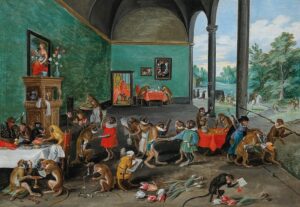
Jan Brueghel the Younger (1601–1678) Allegory of Tulipomania, circa 1640-circa 1650, courtesy Dorotheum.
Purgatory is not a place where one is allowed to forget their sins. Each day the group meets in the “Beanie Babies Board Room.” It is decorated from floor to ceiling with row upon row of cuddly critters. Rumor has it, long ago the place had an entirely different look. Back then, it was called “the Tulipomania” because it was festooned with all sorts of colorful bulbs, but that is another story.
As always, one of the ghostly group is tasked to recite a ballad they have composed, always entitled “How the Beanie Babies Bubble Burst,” which also highlights their own bit part in the drama. Today, it is once again JoAnne’s turn to speak. By now, she and the others know the story by heart. It begins with Ty Warner, a Chicago area toy salesman who became a billionaire in the 1990s with an idea, moxie, and a knack for marketing. Warner’s innovation was to fill simple, but colorful, toy animals with PVC pellets, making them pliable enough to be posed in different positions. The pellets gave the name to the toys, which he christened “Beanie Babies.” Ty also made sure his Beanie Babies had personalized, distinctive branding. The brightly colored animals displayed heart-shaped labels, bearing their creator’s name, “Ty,” as well as a poem devoted to each creation.
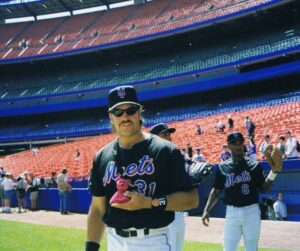
Mike Piazza as a member of the New York Mets poses with a pink beanie bear during Beanie Baby giveaway day at Shea Stadium in 1999. 30 May 1999, Author slgckgc, CCA 2.0 Generic license.
The simplicity of their design allowed Warner to sell them for only $5 each. This modest price meant that most people could afford all nine Beanies of his initial offering, and many more which followed. JoAnne and the others know “the Original 9” all too well. At the start of each “team building exercise,” JoAnne and her fellow spirits must call out the name of each toy animal in unison after spotting them on the shelves: Legs the Frog! Squealer the Pig! Brownie the Bear! Flash the Dolphin! Splash the Whale! Patti the Platypus! Chocolate the Moose! Spot the Dog! Pinchers the Lobster! Of course, since this is Purgatory, it is not as easy as it sounds. Inevitably, “the Original 9” are hidden among many other later Beanies in different spots each time. So frustrating!
As JoAnne explains, cute as they may be, other factors contributed to the 1990s Beanie Babies boom. An initial decision to sell Beanies through local gift shops instead of large toy chains helped ensure that they would be promoted on a grassroots level. Dispersing the cuddly creatures among many small sales outlets also encouraged fans to “hunt” for Beanies in different locations. More significantly, “retiring” individual toys created perceived “scarcity” in the secondary market.
The timing was also fortuitous. The Beanie Babies craze coincided with the dot-com boom. Ordinary folks like JoAnne could not dream of buying Internet stocks, but they could afford to purchase Beanie Babies at $5 and then $10 each. The Internet also helped stimulate demand in other ways. Warner encouraged computer savvy interns at his company to set up one of the first corporate websites. Even more significantly, the secondary market received a major boost from auction listings on what was then a brand-new sales venue called eBay.
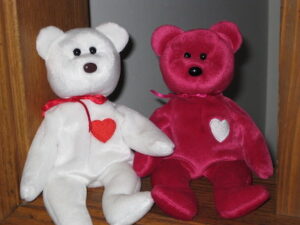
“Beanie Babies (Creative Writing)” by nortoncasey67 is licensed under CC BY 2.0.
At the peak of the boom in 1998, Beanie Babies’ parent company Ty Inc. took in $1.4 billion in sales, while “retired” toys that initially sold for $5 went for as much as $5,000. All the speculatory fever inevitably turned what had been “good clean fun” into something much darker. Soon enough, the prospect of “making a killing” by “flipping” Beanie Babies degenerated not only into unfortunate “investment decisions” like JoAnne’s, but outright theft, counterfeiting, and in one documented case, even murder.
So why did the party finally end? In late 1999, Warner suddenly announced he was going to “retire” the entire line at the end of the year. He also decided to mark this event, as well as the new millennium with the release of one last black toy bear, named “the End.” The bear came with the following poem:
All good things come to an end
It’s been fun for everyone
Peace and hope are never gone
Love you all and say, “So long!”
The “end” turned out to be short-lived. By February 2000, Warmer announced that he would respond to the palpable disappointment of Beanie Babies fans by reissuing the toys, starting with a new white bear named “the Beginning.” That bear came with the following poem.
Beanie Babies can never end
They’ll always be our special friends
Start the fun because we’re here
To bring you hope, love and cheer!
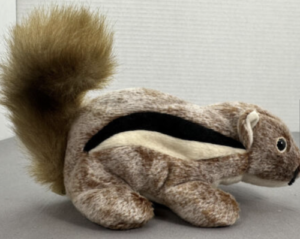
Squirrel Beanie Baby
By this point, however, many collectors felt like they had been “played,” and prices on the secondary market dropped precipitously. Warner was subsequently convicted of tax evasion, adding to his woes. But in the meantime, unlike many Beanie Babies fans, Warner invested wisely in luxury hotels, and he remains a reclusive billionaire toymaker to this day.
With that, JoAnne ended her story with an admission she had never been able to make previously. She told her fellow spirits that her folly and that of others was attributable to one thing only, pure GREED. It had taken her years to make that admission, and to her surprise, her fellow spirits did not argue. Instead, they all nodded sadly but knowingly in agreement.
Here on Earth many question whether “the truth will set you free,” but not in Purgatory. Soon thereafter, JoAnne and her fellow spirits received some wonderful news. They are all being released for good behavior to first-class accommodations elsewhere. Some describe these new digs as “Paradise” and others “Heaven.” Rumor has it that once they move out, the “Beanie Babies Board Room” will be getting a complete makeover. All those adorable Beanie Babies are being replaced with high tech video screens. The new theme will relate to something called “NFTs.”

Owl Beanie Baby
Next Issue: World Culture Cop: Guilt by Association and Other Innovative Crime Fighting Strategies of the Gotham DA’s Antiquities Repatriation Unit
Further reading:
Larry Getlen, How the Beanie Baby craze was concocted — then crashed, The New York Post (Feb. 22, 2015).
Emily Stewart, After the Beanie Baby Bubble Burst, Vox (Jan. 12, 2022).
For more information:
Dark Side of The 90s – S01E04 – Beanie Babies Go Bust, Vice (August 5, 2021).
[1] Peter K. Tompa is a semi-retired lawyer who resides in Washington, D.C. He has written extensively about cultural heritage issues, particularly those of interest to the numismatic trade. Peter contributed to Who Owns the Past?” (K. Fitz Gibbon, ed. Rutgers 2005). He formerly served as executive director of the Global Heritage Alliance and now is a member of its board of directors. This article is a public resource for general information and opinion about cultural property issues and is not intended to be a source for legal advice. Any factual patterns discussed may or may not be inspired by real people and events.
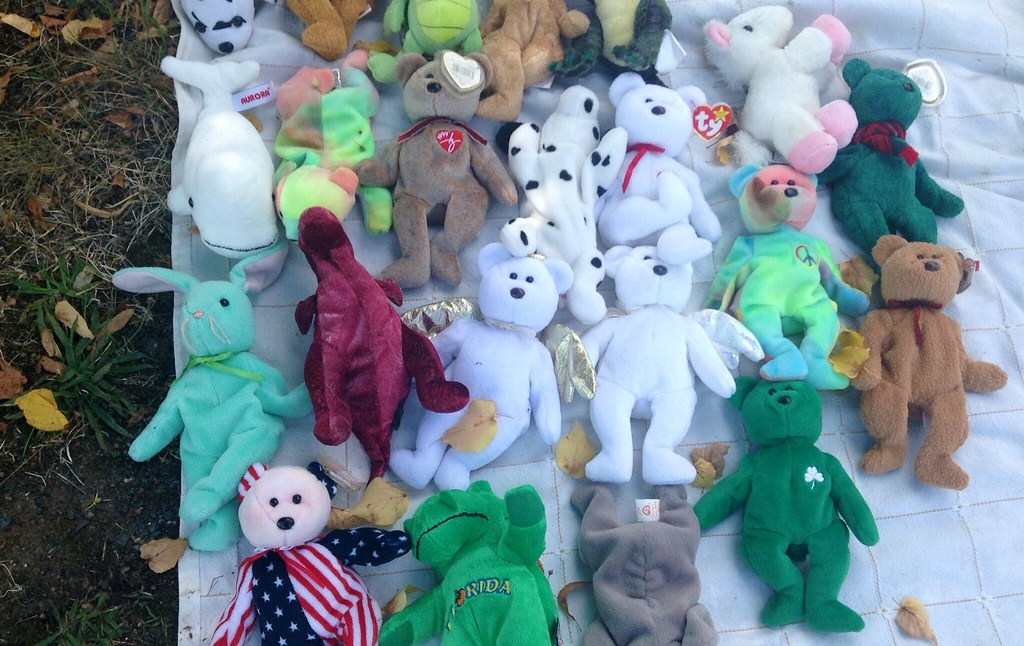 "Yard Sale, beanie babies" by JeepersMedia is licensed under CC BY 2.0.
"Yard Sale, beanie babies" by JeepersMedia is licensed under CC BY 2.0. 

